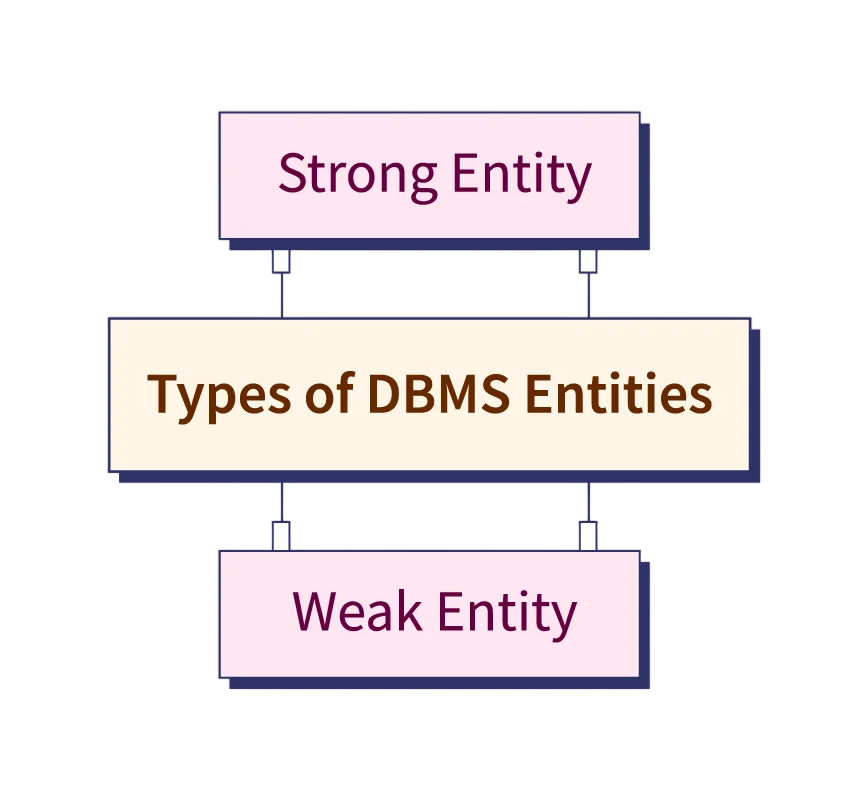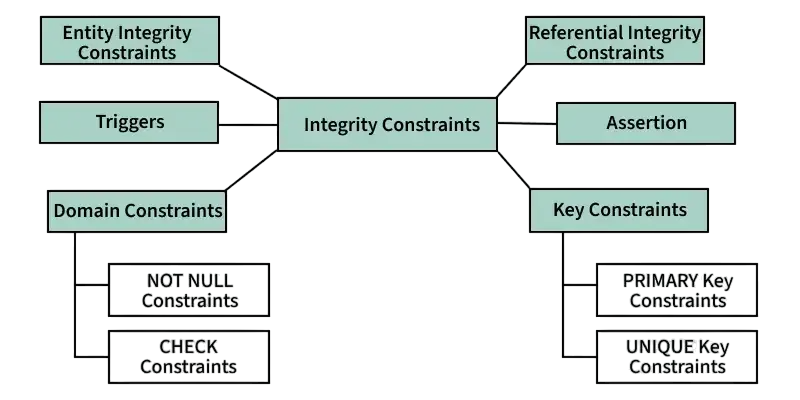
- Entity in DBMS Explained
- Entity Types in DBMS
- Entity Set in DBMS
- The Relationship Between Strong and Weak Entity in DBMS
- Entity Integrity Constraints in DBMS
- Entity and Entity Set in DBMS
- Importance of Entities in Database Design
- Conclusion
Entity in DBMS Explained
In a database control system (DBMS), an entity is a real-international object or belief that may be mainly recognized and defined. Consider it as a noun that may be entered right into a database and changed a person, place, object, or idea. It is viable for entities to have attributes that designate their traits, along with name, address, or age. Effective database control and layout rely upon entities. They make it easier to retrieve and manage facts through allowing us to structurally prepare and keep facts. For packages that rely upon correct facts, entities are vital in making sure facts precision and consistency.In a Database Training Management System (DBMS), an entity refers to a real-world object or concept that can be distinctly identified and stored within the database. Entities represent things like people, places, events, or objects that have a meaningful existence in the context of the system being modeled. For example, in a university database, entities could include students, courses, and professors. Each entity is characterized by a set of attributes, which describe its properties—for instance, a student entity might have attributes such as student ID, name, and date of birth. Entities are fundamental components of the Entity-Relationship (ER) model, where they are visually represented as rectangles in ER diagrams. They form the basis for designing the database schema, helping to organize data logically and define relationships between different entities. Entities can be categorized as strong entities, which have their own unique identifiers, or weak entities, which rely on other entities for identification. Understanding entities is crucial for effective database design, as it ensures data is accurately represented, properly organized, and easily accessible for retrieval and manipulation.
Do You Want to Learn More About Database? Get Info From Our Database Online Training Today!
Entity Types in DBMS
- Strong Entity: One of the primary traits of a sturdy entity is its capacity to exist independently with none different entities. It has a number one key, that is a completely unique identifier for the entity and is used to distinguish it from different entities. . For instance, in a college NoSQL vs SQL, every pupil has a completely unique pupil ID that serves because the number one key. Hence, a sturdy entity performs an critical function withinside the system of handling facts.
- Weak Entity: A vulnerable entity, on the alternative hand, can not exist independently and is predicated on any other entity, referred to as the proprietor entity.A vulnerable entity does now no longer have a number one key of its personal however as a substitute has a partial key, which, while blended with the number one key of the proprietor entity, creates a completely unique identifier for the vulnerable entity. For example, in a college database, a pupil`s magnificence registration can be taken into consideration a vulnerable entity, because it is predicated at the pupil entity (the proprietor entity) for its existence. Weak entities are represented through a double rectangle.

Entity Set in DBMS
An entity set in DBMS is a set of comparable entities. For example, a patron entity set in a income database may also include all of the patron entities withinside the database. Entity units are hired to systematically set up and administer records, Top SQL Optimizationfacilitating streamlined retrieval and manipulation of information.
Here are a few key factors to take into account approximately entity units in DBMS:
- Entity units are collections of comparable entities.
- Entity units will have relationships with different entity units, permitting them to be prepared in a hierarchical structure.
- Relationships among entity units may be categorized as one-to-one, one-to-many, or many-to-many relationships.
- One-to-many relationships exist while every entity in a single entity set is associated with one or extra entities in some other entity set.
- Many-to-many relationships exist while every entity in a single entity set is associated with one or extra entities in some other entity set, and vice versa.
- Entity units may be connected collectively via not unusual place attributes or relationships, taking into consideration complicated records systems to be created.
In short, entity units in DBMS offer a manner to arrange and manipulate records in an established manner, Weak Entity , taking into consideration simpler retrieval and manipulation of information. By expert entity units and their relationships with different entity units, you could create a far better and green database.
The Relationship Between the Strong and Weak Entity in DBMS
A sturdy entity can exist on its own, whilst a susceptible entity can’t.
- A susceptible entity is recognized through its courting with a associated entity, called its proprietor entity.
- The proprietor entity has a completely unique identifier this is used to discover the susceptible entity.
- The figuring out courting among a susceptible entity and its proprietor entity is often a one-to-many courting, ETL Process which means that every proprietor entity will have more than one associated susceptible entities.
- Weak entities are depending on their proprietor entities for identity, and can’t exist with out them.
- The figuring out courting among a susceptible entity and its proprietor entity is commonly represented through a overseas key withinside the susceptible entity`s table.
In summary, the connection among sturdy and susceptible entities in DBMS is primarily based totally on their cappotential to exist independently. Strong entities can exist on their own, whilst susceptible entities are depending on their proprietor entities for identity and can’t exist with out them. Understanding the connection among sturdy and susceptible entities is critical for powerful database layout and management.
To Earn Your Database Certification, Gain Insights From Leading Blockchain Experts And Advance Your Career With ACTE’s Database Online Training Today!
Entity Integrity Constraints in DBMS
Primary key constraints and overseas key constraints are one-of-a-kind classes of entity integrity constraints.Every document in an entity set should have a awesome identifier to pick out every document specifically; this additionally allows to keep away from the advent of reproduction records.An entity set might also additionally have one or extra residences that, taken collectively, uniquely pick out every document withinside the series and on which the number one key constraint may be specified.A overseas key constraint ensures the continuity of the connection among entity units Sql Server Certification. For instance, a overseas key constraint in a income database might also additionally assure that every line object document is hooked up to a valid order document. On an characteristic withinside the based entity set that alludes to the number one key characteristic withinside the figure entity set, the overseas key constraint is described.Here are a few key factors to recall approximately entity integrity constraints in DBMS. A number one key constraint guarantees that every document in an entity set has a completely unique identifier.

Entity Integrity Constraints in a Database Management System (DBMS) are rules that ensure the accuracy and consistency of data within a database. Specifically, entity integrity focuses on maintaining the uniqueness and validity of each entity’s primary key. The primary key is a unique identifier for every record in a table, and the entity integrity constraint mandates that this key must never be null or contain duplicate values. This ensures that each record can be distinctly identified and retrieved without confusion or error. For example, in a student Database Training, the student ID serves as the primary key and must be unique for every student; no two students can share the same ID, and the ID field cannot be left empty. Violating entity integrity can lead to data inconsistencies, difficulties in data retrieval, and overall database corruption. By enforcing entity integrity constraints, the DBMS guarantees that every entity instance remains uniquely identifiable, which is fundamental for reliable database operations and maintaining the overall integrity of the system.
Entity and Entity Set in DBMS
Entity
- Represents a single, distinct real-world object or concept.
- Has specific attributes describing its properties.
- Example: A single student or a single employee.
- A collection or group of similar entities.
- Contains all instances of a particular entity type in the database, Sql And Mysql.
- Acts like a table where each row is an entity and columns are attributes.
- Example: All students in a school database forming the “Student” entity set.
- Entities within an entity set share the same attributes but have different values for those attributes.
Entity Set
Relationship
Importance of Entities in Database Design
Entities play a crucial role in database design as they represent the core objects or concepts about which data is stored and managed. By clearly identifying entities, database designers can organize information in a structured and meaningful way, which helps in accurately modeling real-world scenarios within the system. Entities provide a foundation for defining relationships, constraints, and rules that govern how data interacts, ensuring consistency and integrity. Properly defined entities make it easier to create efficient Database Management System schemas, improve data retrieval, and support scalability as the database grows. Moreover, understanding entities helps in minimizing data redundancy and avoiding anomalies during data operations. Overall, entities are essential for building reliable, flexible, and maintainable databases that effectively serve the needs of applications and users.
Preparing for a Database Job? Have a Look at Our Blog on Database Interview Questions and Answers To Ace Your Interview!
Conclusion
In summary, entities and entity sets are fundamental concepts in database management that help organize and represent real-world objects within a system. While an entity refers to a single, identifiable object with specific attributes, an entity set groups together all such similar objects in the database. Understanding these concepts is essential for designing effective Database Training schemas, ensuring data is structured logically, Types in DBMS and facilitating efficient data retrieval and management.Understanding the idea of entities in DBMS is essential for each person running with databases. By greedy the numerous varieties of entities, their relationships, and the significance of entity integrity constraints, you may create and control a well-dependent and green database.


